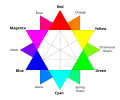
In offset printing, a spot color or solid color is any color generated by an ink (pure or mixed) that is printed using a single run, whereas a process color is produced by printing a series of dots of different colors. [1]
Contents
The widespread offset-printing process is composed of the four spot colors cyan, magenta, yellow, and key (black) commonly referred to as CMYK. More advanced processes involve the use of six spot colors (hexachromatic process), which add orange and green to the process (termed CMYKOG). The two additional spot colors are added to compensate for the ineffective reproduction of faint tints using CMYK colors only. However, offset technicians around the world use the term spot color to mean any color generated by a non-standard offset ink; such as metallic, fluorescent, or custom hand-mixed inks.
When making a multi-color print with a spot color process, every spot color needs its own lithographic film. All the areas of the same spot color are printed using the same film, hence, using the same lithographic plate. The dot gain, hence the screen angle and line frequency, of a spot color vary according to its intended purpose. Spot lamination and UV coatings are sometimes referred to as 'spot colors', as they share the characteristics of requiring a separate lithographic film and print run.
